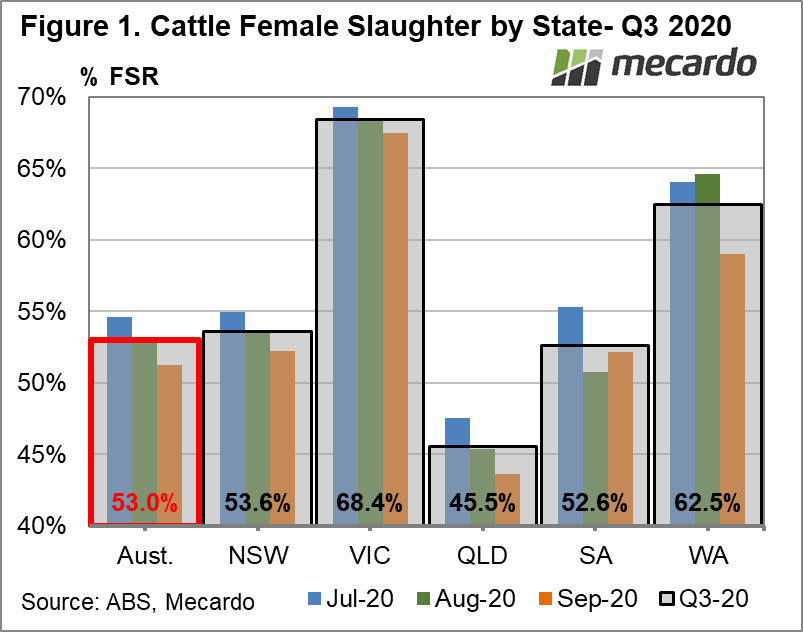The official data on cattle slaughter has been released, and indications are that while we are moving towards a rebuild, we aren’t quite there just yet.
Data on cattle slaughter from ABARES is now released on a quarterly basis, and the headline result this time around has been a concerning one. While it looks like liquidation of breeding females has slowed, as of September this year, as a nation, we still have not hit a rebuild phase. For the July- September quarter, the national figure stands at an average female slaughter ratio (FSR) of 53%, (figure 1). This is a pretty substantial improvement on the last estimate of 55.6% for June 2020, but still a long, long way from the 47% threshold that indicates the herd has entered a rebuild cycle.
This raises the question of whether female cattle slaughter rates have improved, or deteriorated over the course of the three months of the quarter?
To answer that, we can get some guidance from historical trends in female cattle slaughter trends over the last decade. Looking at the data, it can be readily observed that, in general, female slaughter as a proportion of total slaughter tends to back off as we move through July, out to September. By overlaying this monthly trend on the quarterly number, we can get a reasonable estimate of where we might be at as of September- 51.2% (figure 2), which is encouraging.
Furthermore, using this rule of thumb described above, it looks like the home of Australia’s largest herd, QLD might be operating with a FSR of 43.6% for September 2020. Queensland’s threshold Female Slaughter Ratio to signify a rebuild is much lower than the national threshold, so the state still has some way to go before we can say the herd is rebuilding. However, it is moving in the right direction. Even on a quarterly average basis, QLD is tracking at a FSR 45.5%, which is well under the figure of 50% we saw coming out of June 2020.
Unfortunately though, VIC producers still seem to be attracted to the high prices on offer, with a 68% FSR, with WA at 58% not that far behind it. WA seems to have largely missed out on the bounty of solid rainfall that the La Niña weather cycle has brought to the east coast, so, coupled with solid prices for cows, this is not a surprise.
Historical trends are often a good yardstick to use to assess and analyse the cattle market, but we do need to remember that 2020 has not shaped up to be a normal year by any means, so the possibility does exist that the quarterly data may be hiding an early dip in July female slaughter, which masked a ramp up towards September. Only the next release of information will give us a more solid view of where things are going.
What does it mean?
While the data, when combined with historical trends suggests that the liquidation of female cattle is improving, it is happening at a slow rate. As the national female herd is eroded, so does the calf crop, and hence supply into the future. The lower supply will provide support to prices and good quality breeding cows and heifers can be expected to attract a premium in particular.
Have any questions or comments?
Key Points
- A Headline average Female Slaughter Ratio of 53% for Q3-20 indicates Australia may still not be in a herd rebuild phase.
- QLD looks to be closing in on a herd rebuild.
- VIC, WA are still stubbornly in a heavy herd liquidation phase
Historical seasonality applied to infer monthly FSR based on quarterly data.
Click on graph to expand
Data sources: ABS, Mecardo.













